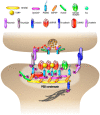Molecular Organization and Regulation of the Mammalian Synapse by the Post-Translational Modification SUMOylation
- PMID: 38474384
- PMCID: PMC10930594
- DOI: 10.3390/cells13050420
Molecular Organization and Regulation of the Mammalian Synapse by the Post-Translational Modification SUMOylation
Abstract
Neurotransmission occurs within highly specialized compartments forming the active synapse where the complex organization and dynamics of the interactions are tightly orchestrated both in time and space. Post-translational modifications (PTMs) are central to these spatiotemporal regulations to ensure an efficient synaptic transmission. SUMOylation is a dynamic PTM that modulates the interactions between proteins and consequently regulates the conformation, the distribution and the trafficking of the SUMO-target proteins. SUMOylation plays a crucial role in synapse formation and stabilization, as well as in the regulation of synaptic transmission and plasticity. In this review, we summarize the molecular consequences of this protein modification in the structural organization and function of the mammalian synapse. We also outline novel activity-dependent regulation and consequences of the SUMO process and explore how this protein modification can functionally participate in the compartmentalization of both pre- and post-synaptic sites.
Keywords: LLPS; SUMO; SUMOylation; biomolecular condensate; post-translational modification; synapse.
Conflict of interest statement
The authors declare no conflicts of interest.
Figures





Similar articles
-
Sumoylation in neurons: nuclear and synaptic roles?Trends Neurosci. 2007 Mar;30(3):85-91. doi: 10.1016/j.tins.2007.01.003. Epub 2007 Jan 22. Trends Neurosci. 2007. PMID: 17241677 Review.
-
Receptor trafficking and the regulation of synaptic plasticity by SUMO.Neuromolecular Med. 2013 Dec;15(4):692-706. doi: 10.1007/s12017-013-8253-y. Epub 2013 Aug 11. Neuromolecular Med. 2013. PMID: 23934328 Review.
-
The post-translational modification, SUMOylation, and cancer (Review).Int J Oncol. 2018 Apr;52(4):1081-1094. doi: 10.3892/ijo.2018.4280. Epub 2018 Feb 22. Int J Oncol. 2018. PMID: 29484374 Free PMC article. Review.
-
E2-mediated small ubiquitin-like modifier (SUMO) modification of thymine DNA glycosylase is efficient but not selective for the enzyme-product complex.J Biol Chem. 2014 May 30;289(22):15810-9. doi: 10.1074/jbc.M114.572081. Epub 2014 Apr 21. J Biol Chem. 2014. PMID: 24753249 Free PMC article.
-
SUMOylation of synaptic and synapse-associated proteins: An update.J Neurochem. 2021 Jan;156(2):145-161. doi: 10.1111/jnc.15103. Epub 2020 Jul 5. J Neurochem. 2021. PMID: 32538470 Free PMC article. Review.
References
Publication types
MeSH terms
Substances
Grants and funding
LinkOut - more resources
Full Text Sources
Miscellaneous

